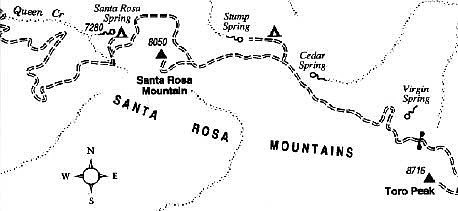 Facebook
Facebook
 X
X
 Instagram
Instagram
 TikTok
TikTok
 Youtube
Youtube
At 8716 feet Toro Peak crowns the Santa Rosa Mountains, an elongated complex of ridges running for some 35 miles between Palm Springs in Riverside County and Borrego Valley in San Diego County. Perhaps nowhere else in Southern California does the juxtaposition of mountain and desert seem so severe. From the summit, the timbered landscape quickly falls away -- to barren slopes, then lower still to the flat Coachella Valley on the east, the saline wasteland of the Salton Sea to the southeast, and the shimmering peaks and valleys of the Anza-Borrego Desert to the south.
Driving up the tortuous road toward Santa Rosa Mountain and Toro Peak is at least half the battle of "getting there." From a point on Pines to Palms Highway (Highway 74) about 20 miles south of Palm Desert and 5 miles east of the Highway 371 junction above Anza, turn south on the Santa Rosa Mountain Road (Forest Road 7S02). For more than 12 miles you ascend on a progressively more rugged dirt roadway (best suited for four-wheel-drive vehicles) to a locked gate below Toro Peak. Park so as not to block the gate, and proceed up the road on foot until you reach the peak. This last section of road was cut into the mountain some three decades ago to service a microwave relay station that sits squarely on the mountain's bulldozed top.
Considering the tedious drive in, you might as well make a two-day trip out of an outing to the uppermost Santa Rosas. Opportunities for car camping abound along the upper, forest-fringed parts of the road. Keep in mind, too, that winter snow visits the area, often starting in December. If heavy, these snowfalls may clog the uppermost five miles of the road, down to about Santa Rosa Spring, until sometime in early April. If they do, your trek on foot to Toro Peak may be much longer, but rewarding nonetheless as the snow-covered road passes through a gorgeous timberland of Jeffrey pine, sugar pine, and white fir. Within a day or two after a fresh dusting of snow, the gently graded upper part of the Santa Rosa Mountain Road can be used as a superb cross-country ski route.
The San Bernardino National Forest has jurisdiction over the area, and yes, you will need to display a National Forest Adventure Pass on your vehicle when you park or camp up there. Contact the Forest Service at 909-884-6634 for more information.


At 8716 feet Toro Peak crowns the Santa Rosa Mountains, an elongated complex of ridges running for some 35 miles between Palm Springs in Riverside County and Borrego Valley in San Diego County. Perhaps nowhere else in Southern California does the juxtaposition of mountain and desert seem so severe. From the summit, the timbered landscape quickly falls away -- to barren slopes, then lower still to the flat Coachella Valley on the east, the saline wasteland of the Salton Sea to the southeast, and the shimmering peaks and valleys of the Anza-Borrego Desert to the south.
Driving up the tortuous road toward Santa Rosa Mountain and Toro Peak is at least half the battle of "getting there." From a point on Pines to Palms Highway (Highway 74) about 20 miles south of Palm Desert and 5 miles east of the Highway 371 junction above Anza, turn south on the Santa Rosa Mountain Road (Forest Road 7S02). For more than 12 miles you ascend on a progressively more rugged dirt roadway (best suited for four-wheel-drive vehicles) to a locked gate below Toro Peak. Park so as not to block the gate, and proceed up the road on foot until you reach the peak. This last section of road was cut into the mountain some three decades ago to service a microwave relay station that sits squarely on the mountain's bulldozed top.
Considering the tedious drive in, you might as well make a two-day trip out of an outing to the uppermost Santa Rosas. Opportunities for car camping abound along the upper, forest-fringed parts of the road. Keep in mind, too, that winter snow visits the area, often starting in December. If heavy, these snowfalls may clog the uppermost five miles of the road, down to about Santa Rosa Spring, until sometime in early April. If they do, your trek on foot to Toro Peak may be much longer, but rewarding nonetheless as the snow-covered road passes through a gorgeous timberland of Jeffrey pine, sugar pine, and white fir. Within a day or two after a fresh dusting of snow, the gently graded upper part of the Santa Rosa Mountain Road can be used as a superb cross-country ski route.
The San Bernardino National Forest has jurisdiction over the area, and yes, you will need to display a National Forest Adventure Pass on your vehicle when you park or camp up there. Contact the Forest Service at 909-884-6634 for more information.
